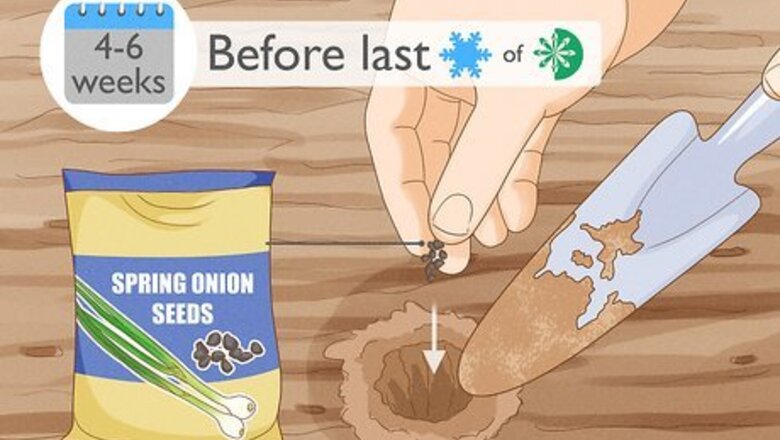
views
Growing from Seeds
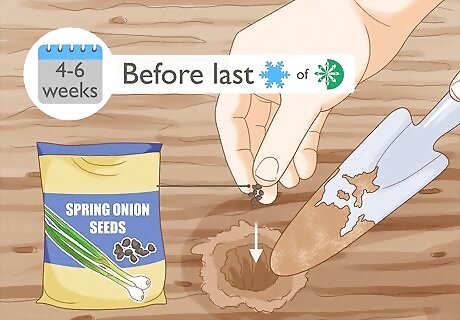
Sow spring onion seeds 4 to 6 weeks before the last frost of spring. This is when the soil first becomes workable. In the northern hemisphere, this happens in April or May when the soil is consistently between 50 °F (10 °C) and 68 °F (20 °C) (or even earlier in warmer climates). Alternatively, start your seeds in an indoor container or greenhouse 10-12 weeks before the last frost. Transplant outside 4-6 weeks before the final frost. Spring onion seeds can be sown anytime during spring through early fall if you're unsure when the last frost will be. For a steady supply of spring onions, sow new seeds every 2 weeks during spring and summer.
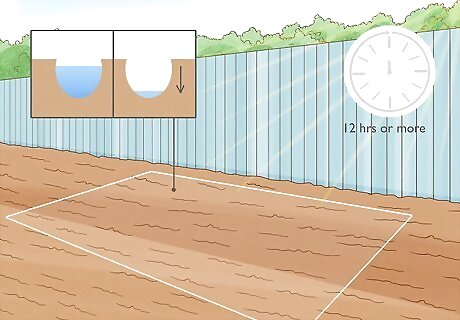
Choose a sunny spot with well-draining soil to plant the seeds. Choose somewhere that’s semi-sheltered, like against the wall of a garage or house, where the plants will get 12 or more hours of full sun per day. If you’re growing your onions indoors, place the container on a windowsill that gets regular sun. Prepare your soil by adding compost, peat, or sand to make it more friable (crumbly). This makes for better drainage and prevents soggy or rotten roots. Spring onions grow best when the soil’s pH level is between 6.3 and 6.8. If your soil is too acidic (has a pH level below 6), add limestone to neutralize it.
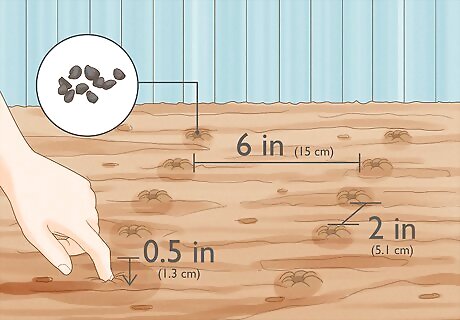
Plant the seeds 0.5 in (1.3 cm) deep, 2 in (5.1 cm) apart. Since the holes are so shallow, real digging isn’t required—just press your finger into the soil to make a depression. Cover the seeds with about 0.5 in (1.3 cm) of fine soil. Plant rows of seeds at least 6 in (15 cm) apart. Planting spring onions 2 in (5.1 cm) apart prevents the bulbs from maturing to their full size, giving the onions their sweeter flavor. If you don’t have room for rows, scatter the seeds in spare patches around the garden since the plants don’t take up much space.
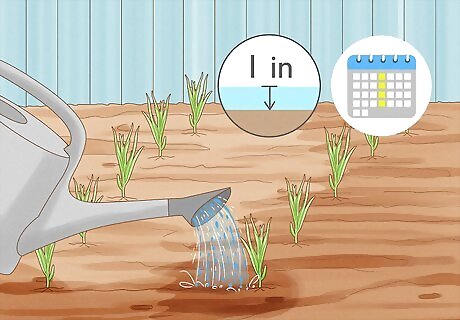
Give your seedlings 1 inch (2.5 cm) of water per week. Rainfall will usually take care of this. If not, thoroughly soak the soil once a week (or more often if your soil is sandy). 1 inch (2.5 cm) of water will wet sandy soil to a depth of 10 inches (25 cm) and clay soil up to 6 inches (15 cm). Use a trowel to check how far down your water reaches. If only the top 2 inches (5.1 cm) are wet, add more water.
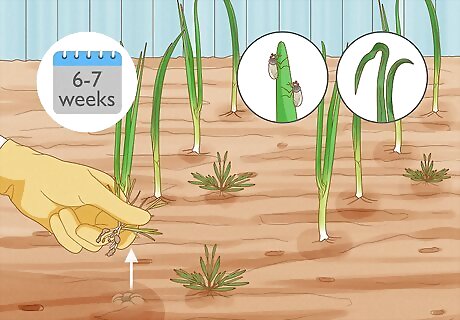
Weed your spring onion patch and watch out for pests and fungi. Remove weeds by hand (no chemical weed killers) to eliminate competition for water and nutrients. Since spring onions grow quickly, pests and disease are rarely a problem. Look for the following during the first 6 to 7 weeks of growth: Onion flies or lesser bulb flies: These pests burrow into the bulbs and cause the leaves to wilt and the bulbs to rot. Pack the surface soil tightly to make burrowing more difficult, and dig up infected plants to prevent spreading. Fungal infections: Fungi forms when onions are too damp and begin to rot. Look for spots, patches, or lesions on the leaves and stems. Destroy infected plants and use organic fungicide to prevent spreading.
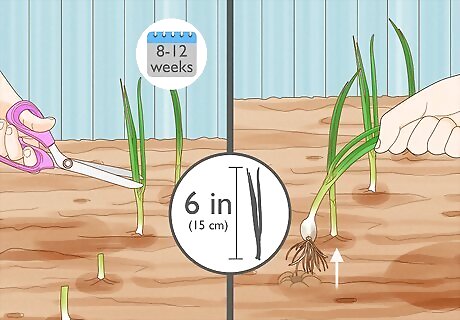
Harvest in 8 to 12 weeks when the stems are about 6 inches (15 cm) tall. The earliest onions will be ready to eat after 2 months, but some may need another 2 to 4 weeks. Snip off the edible stems with scissors or shears near the base of the plant and leave the bulb in the ground—the stems will regrow 4 or 5 times throughout the season. Cut the stems farther away from the ground to produce a plant that is larger than the average spring onions you’d find at the grocery store. Loosen the soil around each bulb gently with a trowel and gently tug the plant out of the ground to harvest the entire plant (the bulbs are delicious too!). Stems and bulbs will last several days on a countertop at room temperature. For longer storage, put bulbs or stems in an airtight container or bag and refrigerate for up to 2 weeks.
Growing Root Cuttings in Water
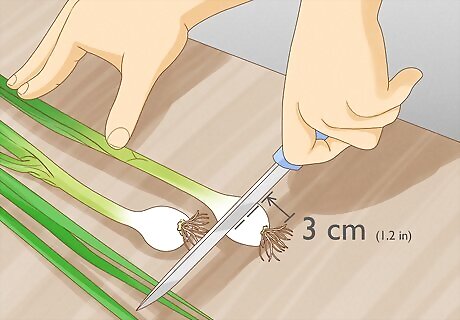
Slice your onion about 3 centimetres (1.2 in) above the roots. Use a sharp knife or garden shears to make a clean cut for faster growth. Set the piece with roots attached to the side and use up the remaining stems and bulb as a garnish or ingredient in your favorite summer dishes.
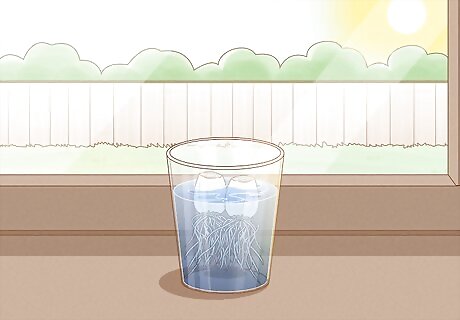
Place the cutting root side-down in a small jar of fresh water. Make sure the roots are fully submerged and keep the jar on a sunny windowsill or balcony. Change the water at least once a week. Once the stems are fully grown, you can snip and use them straight from the jar as needed.
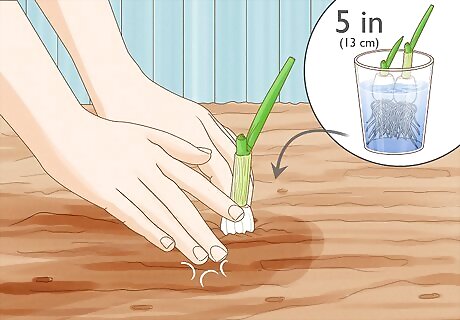
Put the new plant in soil when the stems are about 5 inches (13 cm) tall. If you keep them in water indefinitely, the plant will get weaker and eventually stop growing. Once replanted, the stems will keep regrowing after your cut them about 4 or 5 more times during the season.
Replanting Roots and Bulbs
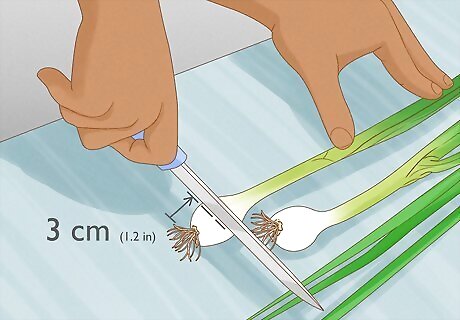
Cut the onions about 3 centimetres (1.2 in) from the roots. Use a sharp knife or shears—a clean, straight cut will result in faster regrowth than a jagged one. Use the rest of the bulb and the stems in your cooking within a day or 2 for maximum freshness. Alternatively, purchase spring onion sets instead of cutting the roots. Sets are previously harvested bulbs that have been dried for replanting later. Onion sets are more expensive than seeds, but are easier to maintain and are ready to harvest sooner.
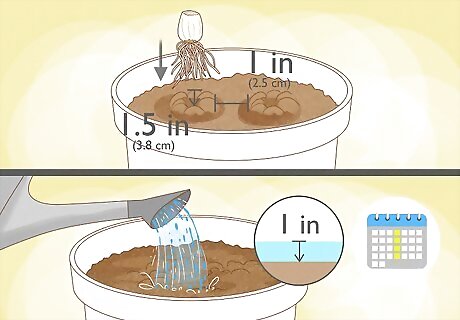
Plant your cuttings root side-down in a pot or your garden. Plant them deep enough so that just a little bit of the stem is visible above the soil. If you pot them, place the pot on a sunny windowsill or patio. Make sure they get about 1 inch (2.5 cm) of water per week. If you’re planting onion sets, bury them 1.5 inches (3.8 cm) deep and 1 inch (2.5 cm) apart in the same conditions you would plant seeds or cuttings. Make sure onion sets are planted with the roots facing down and the pointy tip (which might already have some green on it) facing upward.
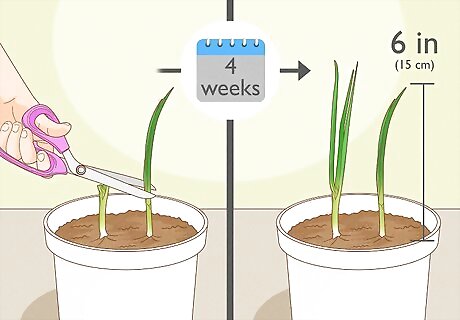
Snip off the stems as needed once they’re about 6 in (15 cm) tall. The plant will regrow stems about 4 or 5 times before you need to replant a new root system. It will take about 4 weeks or so for both root cuttings and sets to grow usable stems and bulbs.



















Comments
0 comment